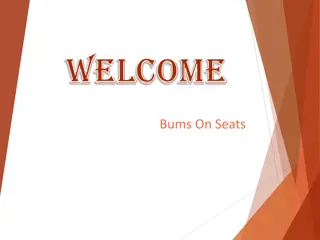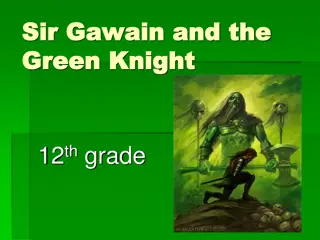The Fascinating Mathematics Behind Knight's Tours and Chessboard Puzzles
Explore the intriguing world of Knight's tours and chessboard puzzles, from closed tours to open tours, with historical insights and mathematicians' quest for generalization beyond the standard 8x8 board. Delve into the challenges, solutions, and classifications that have captivated minds for centuries.
Download Presentation

Please find below an Image/Link to download the presentation.
The content on the website is provided AS IS for your information and personal use only. It may not be sold, licensed, or shared on other websites without obtaining consent from the author. Download presentation by click this link. If you encounter any issues during the download, it is possible that the publisher has removed the file from their server.
E N D
Presentation Transcript
The Mathematics of Chessboard Puzzles
The Closed Knight s Tour
The Closed Knights Tour Can the knight use legal moves to visit every square on the board exactly once and return to its starting position? Why do we only pay attention to the knight? TrivialCases
How many closed knights tours are there on an 8 8 board? 26,534,728,821,064 How many open knight s tours are there on an 8 8 board? ?
The closed knights tour has a long mathematical history. Euler published tours for the 8 8 board in a 1759 paper.
Once a problem is solved, mathematicians want to generalize the problem as much as possible. Thus, we do not restrict ourselves only to the standard 8 8 chessboard. Generalizations are quickly made to the square board, the rectangular board, three dimensional boards, etc.
In his October, 1967 column in Scientific American, Martin Gardner discusses the knight s tour on rectangular boards and other mathematical problems involving the knight.
The Rectangular Chessboard 1 6 27 24 5 30 4 25 7 2 26 29 13 8 28 23 11 14 22 17 19 10 16 21 3 12 9 20 15 18 1 28 22 11 27 30 12 15 7 26 16 13 21 2 23 8 17 6 10 29 4 19 14 25 3 20 9 24 5 18
Classifying The Boards In 1991, Allen Schwenk completely determined which rectangular chessboards have a closed knight s tour. An m n chessboard with m < nhas a closed knight s tour unless one or more of the following three conditions hold: (a) m and n are both odd; (b) m = 1, 2 or 4 ; (c) m = 3 and n = 4, 6 or 8.
Condition (a): m and n are both odd. Recall that a legal move for a knight whose initial position is a white square will always result in an ending position on a black square and vice-versa. Hence, every tour representing the legal moves of a knight alternates between black and white squares.
Condition (a): m and n are both odd. Suppose m and n are both odd. There will exist an odd number of squares on the board. The number of black squares will not equal the number of white squares. No closed tour can exist.
Condition (b): m = 1, 2 or 4. Suppose m = 1 K Suppose m = 2 K
Condition (b): m = 1, 2 or 4. For 4 n boards we require a more complex coloring of the board than the traditional black and white coloring.
Condition (b): m = 1, 2 or 4. Note that a knight must move from a brown square to a black square. Likewise, a knight must move from a white square to a green square. Two closed cycles are now forced to exist and no closed tour exists for the 4 n board. Solomon Golomb
Condition (c): m = 3 and n = 4, 6, or 8. For the 3 4 board consider the squares 1, 3 and 11. These squares have only two possible moves. 1 4 7 10 2 5 8 11 3 6 9 12 The cases for the 3 6 and 3 8 boards are shockingly similar.
The Existence of a Closed Tour 1 4 7 26 13 28 11 22 19 16 A D G J 6 25 2 29 8 23 14 17 10 21 L I B E 3 30 5 24 27 12 9 20 15 18 C F K H























